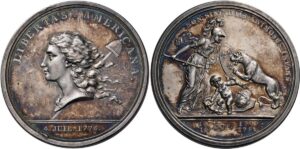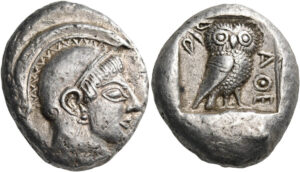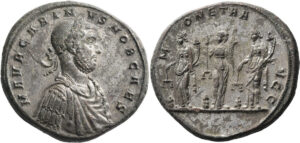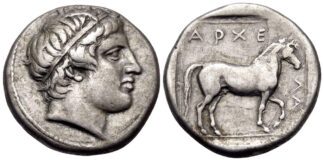Highlights From Sicily to the USA at Nomos 21
It is about time to report on the results of Nomos 21, which took place on November 21st, 2020. Why so late? Well, it has been quite a time, fraught with worries about the Covid pandemic, unparalleled degrees of political craziness, and grim-looking grey skies: sometimes that glum atmosphere just takes over and you begin sliding into a condition of anomie that could be disastrous… But then, suddenly, like a bolt from the blue, thoughts of coins come into your head, and in the same way rays of the sun pierce and dispel the deepest gloom, your mood lightens and your mind begins to fill with visions of tetradrachms, obols, denarii, solidi and more, joyously swirling around like the figures in Botticelli’s la Primavera! Can you imagine how much better the world would be if considerably more people collected coins? People from all countries and of all ethnic, religious and racial groups would find common ground, understanding, and friendship thanks to their shared hobby. Everyone would become more knowledgeable about history, art, myth and economics; thus, the inimical schemes of the extremists of the far left and far right would be repudiated, the conspiracy theorists shunned, the heritage fanatics foiled, and the crazies reined in. In other words, the extensive collecting of coins by peoples all over the world would doubtless lead, in time, to a modern-day Edenic Utopia!
In any case, while we are waiting for the actions of coin collectors and numismatists to make “redeunt Saturnia regna” the world’s watchword, we ought to not only take a look at some of the wonderful results of Nomos 21.

As always with our Nomos Auctions, we give each lot an estimate, which is what we consider would be a reasonable price for that lot – often a very reasonable one! We try to avoid estimates that are unrealistically high, often due to either an owner’s over-optimistic hopes or our own bewitchment; equally, we do our best not to have unrealistically low estimates since they would be unfair to prospective bidders, something we do not want to be. The starting price for each lot is 80% of the pre-sale estimate, unless there are numerous pre-sale bids that require us to open at a higher price. As a result, in every sale we have coins that sell at the starting price; at less than, around or above the estimate; or sometimes, if there is a lot of competition from determined bidders, at very considerably more than the estimate. That is why auctions can be so enthralling and unpredictable. They also can be very exciting, especially in floor sales when opposing bidders begin to fiercely glare at each other and seem ready to come to blows! One of the most amusing of those imbroglios took place when I was first at Bank Leu, at Auction 20 in April 1978. That was quite a sale, which had a plethora of amazing coins, but it also had a very fine selection of books, and it was with the books that a memorable confrontation took place, between the then dean of English coin dealers, Georges Muller of Spink’s, and the up-and-coming Michel Bendenoun of Tradart. The sale contained two really fine sets of Jameson, lots 485 (estimated at 4,000 CHF – vols. I-II in half leather and III-IV paper bound as issued) and 486 (estimated at 4,500 CHF – fully bound in half leather in six volumes). The first opened at 3,800 CHF and, in a fight between GM and MB, went to Tradart at 5,250 CHF. Then the second also opened at 3,800, and the same two bidders fought it out until it finally went for 7,000 CHF, again to Tradart. At that point Georges turned to his left to stare at Michel, who sat about four seats away from him at the big table, and, in a furious whisper that could be heard over half the room, hissed “What do you want two for? One for you…and one for your wife?!”
Now, in the present Covid situation floor fights like this are a thing of the past – but spirited bidding, on the floor, on the internet, online and on the telephone, made our sale an exciting one.
- The two highest prices in the sale were for two coins that could not possibly be more different from each other. Lot 80, which was estimated at 450,000 CHF, sold to a floor bidder for an even 500,000 CHF! Lot 80 is, of course, the great tetradrachm of Naxos, once in the collection of E. Dresse de Lesbioles of Liege, who acquired it from Ars Classica auction XVII in 1934.

- Then of course, there was the last lot of the sale, perhaps the most important and evocative of all American medals, lot 396 the Libertas Americana medal of 1783. Estimated at 100,000 CHF it sold to one of our floor bidders at 108,000 CHF!
- Lot 21, the Biunx from Capua ex Sartiges, Berlin, Löbbecke and Bunbury. Estimated at 500 CHF, it sold for 2,400 CHF! Rarity and provenance make a difference.
- Of course, quality is vital too. This Nomos, lot 27, from Tarentum, which comes from a European collection and was acquired around 2000, was estimated at 800 CHF, it went for 4,000 CHF!
- Also selling for 4,000 CHF, but this time with an estimate of 1,400 CHF, this didrachm from Himera, lot 68, was published by Westermark and comes from a Gans sale in Los Angeles in 1960 – from its appearance it must come from an old collection, but if Westermark could not find it, it might mean that it entered a private collection without ever having passed through a public sale and could have a pedigree going back well before World War II.
- The following lot 69 was another, but later, didrachm from Himera. It has a provenance going back to at least 1977, was estimated at 1,500 CHF, and sold for 8,000 CHF!
- This exceptional litra from Naxos (lot 81) was owned by a now retired Padre who is selling his coins to be able to rebind his collection of missals. It is really a lovely coin, well worth its estimate of 500 CHF – but it sold for a massive 4,000 CHF!
- Lot 146, the second known stater of Alexander of Pherai – it has the head of Ennodia on the obverse and, on the reverse, a mounted figure of Alexander himself. Estimated at 12,500 CHF it sold to a very advanced collector for 15,000 CHF.

- Lot 152 is dating to c. 500 BC, this is quite an extraordinary Athenian tetradrachm: it is of very heavy weight and seems to be an unusual variety of Seltman’s group M. It’s fascinating quality justified its estimate of 15,000 CHF, but it sold for 17,000 CHF. I wonder whether we will see an article about it sometime in the future.
- Corinthian and Corinthian-type staters have always been a very popular collecting area. Like some series of Roman Republican denarii, they have a vast series of symbols so that trying to obtain every interesting variety can be a lifetime project. Lot 164 is toned, in splendid condition and has a very attractive boar as its symbol: after a huge fight it sold for 5,500 CHF!
- The Samian drachm, lot 198, goes back to the collections of Sir Hermann Weber and Robert Carfrae, and is another coin, which joined our 4,000 CHF Club: its estimate was 650 CHF!
- Lot 266 is a type of coin that I have known about for a very long time, but this is probably the first one I have ever had. Unlike the vast majority of Ptolemaic tetradrachms, instead of bearing the head of the dynasty’s founder Ptolemy Soter, this piece has a true portrait of Ptolemy III Euergetes. Back in the very early 1960s I bought a copy of E.T. Newell’s Royal Greek Portrait Coins (Racine, 1937) for $2.50 from an aged coin dealer who had a shop in a basement across the street from my grandparents. Beautifully written, very well illustrated and fascinating, I loved reading it then and still do. Anyway, a coin of this type appears as fig. 7 on p. 104; Newell’s discussion of the portrait has stayed with me since I first read it. Estimated at 2,500 CHF – it sold for 4,000 CHF!
- But we also had another Ptolemaic portrait coin, this time an extremely rare tetradrachm of Ptolemy V Epiphanes, struck in 199/8 BC to celebrate his coming of age. Lot 271 estimated at 3,500 CHF: it sold for 15,000 CHF!
- Sometimes a really rare coin “slips through the cracks” and sells to an astute collector for what he, and we, feel is a bargain price! This is lot 281, a denarius of C. Hosidius C.f. Geta – a variety of Crawford 407/2 that lacks a spear piercing the boar on the reverse. Very probably a die engraver’s mistake, this spear less-boar is very difficult to find: in the Mesagne Hoard (which I helped the late Charles Hersh to publish in ANSMN 29, 1985), we had 121 examples of the normal type and only 4 of this variant. When this coin appeared in NAC 59 in 2011 it was estimated at 500 CHF and sold for 1,000 CHF: we estimated it at 650 CHF, and it sold to an extremely happy collector for 520 CHF!
- But other rare coins do not slip through the cracks: this aureus of C. Cassius Longinus, lot 289, more than doubled its estimate of 35,000 CHF to sell for 75,000 CHF!
- A coin’s rarity and style play a great part in its auction price: lot 328 is an unpublished coin of Bruzus in Phrygia and bears an extraordinarily fine portrait of Aelius Caesar. It was estimated at 500 CHF, but it soared up to 1,800 CHF.
- The Roman Provincial tetradrachm coinage of Antioch sometimes bears remarkably elegant and impressive portraits: lot 344 is certainly one of them. I have always liked them a great deal and it is quite clear that others like them too: this piece soared up to 1,700 CHF!

- Yes, here it is again, lot 352 with its remarkably elegant and noble portrait of Carinus Caesar. Every time I see it, I like it the more, and so did its purchaser. Estimated at 50,000 CHF it was obviously not within everyone’s reach, but one collector made a special trip to Zurich, just ahead of a lockdown, in order to see it for himself. At the auction he was on the telephone and got it, against a number of other bidders, for what he thought was the very reasonable price of 75,000 CHF. Frankly, I think it was reasonable too, and that is not just because I was the auctioneer!
- While the Carinus medallion sold for what can only be termed a reasonable price, lot 386, a unique weight for an electrum trachy of Theodore I of Nicaea, sold for what simply has to be termed a bargain price! It was estimated at 500 CHF and was hammered down for only 550 CHF! This is the kind of piece that gets thrown into a bag of miscellaneous coins by someone who does not know what it is, and who doesn’t think it is worth the time to find out. Sure, it is worn, but it is truly historically exciting and is an evocative relic of that dark period after the treacherous Crusader conquest of Constantinople. Where was this piece used, how long did it continue to serve as a weight, and where did it end up? This may be a humble object but the story of its 800-year existence would be a fascinating one if only we knew what it was!
You can find all lots and prices of Nomos 21 at the Nomos website.





